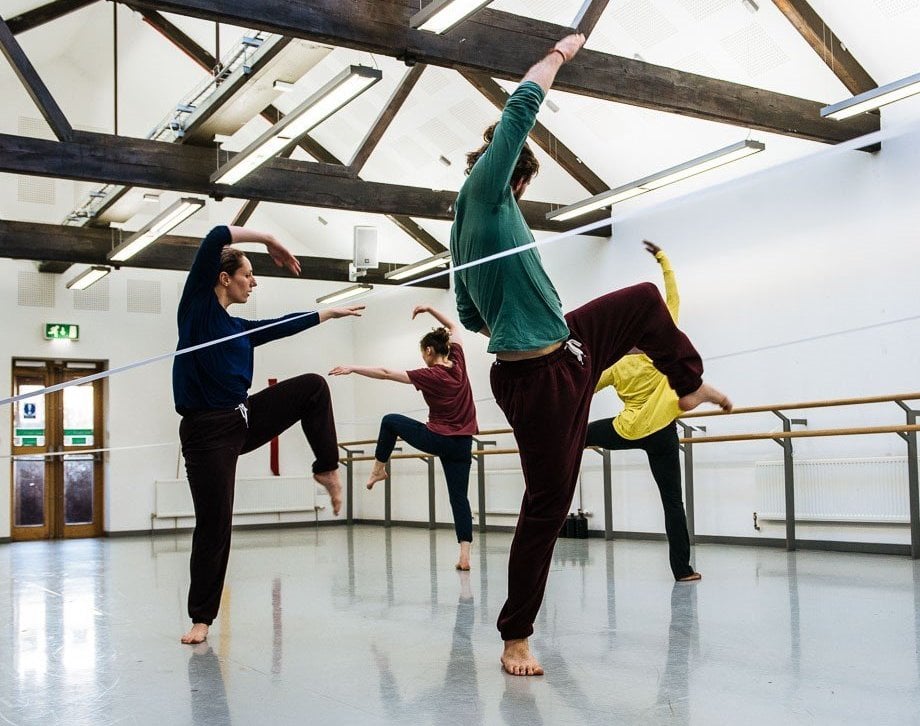
Dancers at a Rosina Bonsu residency
Dance partners
As well as being a studio space for independent dancers and choreographers, Glasgow's The Work Room is also an empowering artist-led support network, says Anita Clark.
The Work Room was set up ten years ago by a group of dance artists in Glasgow, to respond to the challenges and frustrations they faced in their work. Artists had been agitating about the lack of resources for dance to develop in the city, and particularly the lack of suitable space to create in.
The opportunity for the studio space came about when Scottish Ballet developed its new headquarters at the Tramway. The vision encouraged by the Scottish Arts Council and Glasgow City Council was that this should include studio space for independent dance artists.
Many artists are often in positions of great vulnerability, holding the burden of financial risk on their projects
From the start, we wanted a space where dance artists could work – a home for researching practice and creating new projects. It was vital that the organisation was artist-led. This aim informed our membership structure, which seeks to build a culture of responsibility and accountability and feed a strong culture of grassroots leadership.
The ethos also permeates how we operate: the priorities of our members inform the programme and we use a peer review process, with working groups making the selection decisions for residencies and other projects.
The organisation has evolved substantially over the past ten years. Our membership has increased and we now have a secure funding base that enables us to financially support artists when they are in residence, and employ two members of staff to manage the organisation and programme.
Residency programme
Our residency programme provides time, space and finance for research, development and experimentation. We have hosted over 250 artist-led residencies, involving more than 500 artistic collaborators, with work being developed in the studio and then produced, presented and toured in Scotland, across the UK and internationally.
Natasha Gilmore undertook our first residency in January 2009. Her company, Barrowland Ballet, has developed many of its performances in our studio, including Whiteout. It premiered at Dance International Glasgow in 2015 before touring round Scotland. It was also part of the Made in Scotland showcase at the Edinburgh Fringe in 2016, and toured internationally this summer.
Natasha says: “Dance takes quite a lot of thinking time in the space. You’ve got ideas, but you don’t come in with a ready-made script. You have to explore your ideas in real time with the dancers. That’s how ideas change and evolve.”
However, not everything leads directly to performance. It's also important to have a safe space for artistic research, development and experimentation outside the production process.
An antidote to competition
The Work Room is more than a studio. Our strength lies in our artist-led approach: we are a community of 140 individual artists working in dance. Some create performance for the stage, others work in participatory settings, developing dance with people and communities. Some create work for the screen using digital technologies and others present work in galleries or public spaces. This is a powerful network of connections, experience and skills.
The arts industry can create a climate of competition and put substantial pressure on independent artists and small-scale companies. This is unhealthy for individuals and also for the sector. We all talk about ‘sustainable careers’, but the structures we operate in often neglect the fact that to be independent and freelance is also to be unwaged. Many artists are often in positions of great vulnerability, holding the burden of financial risk for their projects.
We are interested in how we can be an antidote to the fever of competition through cultivating generosity and collaboration. We are keen to develop approaches that enable independent artists to be more influential within our industry and place greater value on the leadership that comes through their practice. When artists seek to engage and influence change, they are frequently investing a great deal of their own time and resources to do so.
In small ways, the Work Room tries to challenge this and amplify the artist's voice. These include covering the costs for artists to attend industry networking events, paying artists for their time in a consultation, and sharing the administrative resources that we have.
Anita Clark is the Director of The Work Room.
theworkroom.org.uk
Join the Discussion
You must be logged in to post a comment.